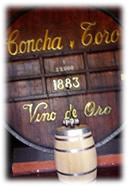
Words
and Photos by Ann Hattes
Get a Taste of Chile's Historic Wine Scene
If
you're a wine aficionado, you already know that Chile was the first wine producer
in the New World, producing wines 200 years before California. And if you're not
a wine aficionado, experiencing the wine scene in Santiago might just convert
you.
Traveling
in Santiago is a pure delight, as it is one of the few capital cities in the world
with easy access to both skiing (30 miles) and beaches (60 miles). The majestic
Andes can be seen from almost anywhere in the city. In Santiago, museums, art
galleries, and handcraft centers beckon to be explored.
 |
| Enjoy
views such as this while exploring the Maipo Valley of Chile. |
You'll
definitely want to explore the Maipo Valley, one of the country's most important
winegrowing areas near Santiago. The region combines the "trilogy" to
produce good wine: climate, soil, and vinestock. Small vineyards have flourished
here since colonial times when wine was produced for Catholic church communion.
The
wineries often have stately manor houses and spacious estate grounds like those
at Cousino Macul that have been in the same family since 1856. Many times visitors
find specialty wines not available on the international scene due to limited production
quantities. One such, produced at Concha y Toro, is Late Harvest, an exquisite
delicate dessert wine that really can be enjoyed anytime.
The
guide at Vina Concha y Toro, Chile's largest winery, explains that dry summers
in the Maipo Valley are ideal as irrigation of vines permits exact control of
water. Contrast this with French wine that is purchased by the year because of
the weather.
 |
| Touring
a Chile vineyard. |
The
Vina Concha y Toro guide also points out that Chile is the only country free of
disease, due to its isolated location with the Pacific Ocean to the west, the
Andes to the east and the dry desert to the north. When the phylloxera fungus
decimated European vineyards in the late 1800s, Chilean vines were used to replenish
the stock.
Near
to the village of Pirque and Vina Concha y Toro is the beautifully designed ultramodern
facility for Almaviva, a joint Franco-Chilean venture between Rothschild and Concha
y Toro. As of May 2001, it became 100% Rothschild Maipo Chile, with plans to develop
a range of wines starting with Escudo Rojo.
Kenneth
T. Chase, a classically trained wine merchant and creator of Delta Airlines' Vinum
program and Wine Academy, recommends visiting the Santa Rita Winery, "the
people who started it all," plus Vina Cousino Macul, and Montes.
Further
afield, Chase suggests Bodega (Cellar) Miguel Torres on the Pan American Highway
six miles south of Curico.
"Just
expect to travel a lot," advises Chase. "It's not like being in Napa.
Things are pretty well spread out. For three wineries, plan three separate days.
The scenery is spectacular, as diverse as Canada with mountains, desert, snow."
Chase,
who hails from Canada, blends and creates wine for top restaurants and hotels
around the world. He also serves as wine consultant for Delta Airlines and has
done similar work for Cathay Pacific Air Lines, Canadian Airlines, and Royal Carribean
Cruise Lines.
In
November 2000, he participated in Delta's inaugural flight to Santiago from Atlanta
to aid in the selection of Chilean wines to put on board Delta flights. All the
Chilean wineries were invited to submit samples. Asked how he would pare down
50 to 75 wines for a celebrity panel tasting, Chase says simply: "You do
it with the nose."
"If
the aroma is attractive, then I taste. If it isn't attractive, I discard."
"The grape itself gives you the personality," explains Chase. "If
I say the name 'rose,' you instinctively know what that smells like. It's the
same with Chardonnay. With the same fruit, we all expect nuance of aroma. But
the soil will affect the taste."
And
so Chase concludes: "We always say in the wine business, personality comes
from the grape but the character comes from the soil."
"Chilean
wines have been a very big success story for us," continues Chase. "The
price/quality is true. People know it's a great value. Most of the Chilean wines
we put on board, you can't buy. But I don't have the luxury anymore to have those
tiny wineries as much as I used to because our Vinum program is getting known."
Chase
speaks of a Chilean Carmenere selected for Vinum. "The taste is awesome but
it's such a hard word to say, I don't think it's going to catch on."
 |
| Mmm...a barrel full of wine at Concha y Toro. |
Hugh
Johnson in his handy guide Pocket Encyclopedia of Wine (Simon & Schuster,
$13.95), writes: "The news for fans of Chilean Merlot is that most of it
(60 -90 percent) might not be Merlot at all, but the rare Bordeaux variety, Carmenere.
The Chileans have only recently recognized Carmenere as an official variety for
making wines…..the EU has yet to do so….….Many winemakers feel
that the best wines will be from vineyards where the varieties are interplanted."
There
are tales about a prominent Hong Kong dentist who, refusing to fly without exactly
the right wine, brings along a few bottles of his favorite vintage, a corkscrew
and crystal glasses. With the Vinum selection available, Delta Airlines has one
of the top ten "Cellars in the Sky" according to Business Traveler International.
With
Vinum, Delta's first class and business flyers don't have to bring their own wine
along!
"Eighty
percent of the wines on board you can't buy stateside," explains Chase. "They
are very, very special tasting wines."
Chase
sums up: "We hope that the magic will spread with knowledge."
As
for accommodations in Santiago, you can choose from many first class accommodations
such as the Hyatt Regency (www.santiago.hyatt.com)
located only minutes from downtown in the city's exclusive diplomatic and residential
district. It's also been named the #1 Caribbean/Latin Hotel by readers of Conde
Nast Traveler. All 310 rooms and suites frame a spectacular view of the city
and the majestic Andes beyond in windows as tall and wide as the room itself.
So draw back the drapes, grab a bottle of local wine and enjoy the panoramic sights
(and the distinct taste) of Santiago.